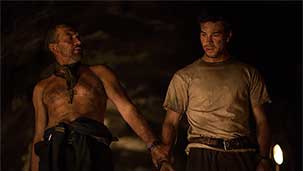I love disaster movies, don’t you? Especially the ones “based on actual events”. I love disasters so much that when I saw Titanic I planned to nap through the first half’s lovey-dovey romantic subplot and told my friend to wake me up for the iceberg. I’m such a fan of the TV show Mayday that I actually have a favourite plane crash (Potomac River, Air Florida, 1982). There’s something about watching a dramatized real-life horrific event that appeals to my love of the underdog. It’s fascinating to watch regular people find the strength to survive. But I have a feeling that you watch these movies with a different perspective.
You’ve worked on other films and television series, but I bet doing health & safety for a film whose entire plot relies on the very lack of workplace health and safety gave you an added sense of purpose. In 2010, 33 Chilean miners were trapped more than a kilometer underground after a series of mine collapses. Miraculously, they survived for more than two months before their heroic rescue. The 33 chronicles their story.
You don’t have a job that allows you to blithely gloss over details and say, “meh, good enough”, but it seems the writers of The 33 don’t share that sentiment. Ordinarily I have a very difficult time overcoming a conceit which sees a group of Spanish actors, playing Chileans, speaking English with Spanish accents. I cringe when the first few minutes of a film sets up so many clichéd scenarios – the miner two weeks from retirement, the miner considering changing jobs before the birth of his child, the miner who has the day off but volunteers to work anyway – that I half expect a baby-faced soldier to pull out a picture of his “girl back home”. But I forgive these trivialities the same way I forgave white people playing Spanish people in Alive and The Impossible, because, impending disaster!
You are responsible for assessing risks, identifying hazards and recommending safety measures. Your job is the most important on the set, but you still have to answer to the director, and hope that he or she is just as committed to the safety of the cast and crew. In The 33, your job is done by Lou Diamond Phillips, as the safety foreman Don, his complaints to the higher ups about an impending catastrophe have fallen on deaf ears. When the inevitable happens, it is indeed terrifying, but quick. The real drama begins after the miners realize they are trapped with only enough supplies for ten men for three days.
Above ground, the families, led by a defiant Juliette Binoche as Maria, the estranged sister of one of the miners, demand the foot-dragging government spare no expense in attempting to free the miners. But after more than two weeks with no luck, everyone is about to give up hope. Except for “Super” Mario Sepulveda played by Spanish Harrison Ford, Antonio Banderas. As the de facto leader, Mario keeps the men’s spirits up, divvies up their dwindling supplies, and argues with Don over what they should do next. In one of the film’s best scenes, Mario serves up the last of the food and we are treated to a dream sequence involving their wives and girlfriends feeding them their favourite dishes. Normally this kind of chauvinistic scenario would make me cringe, but it was so well imagined and executed that it intensified the impact of the miner’s dire situation, and humanized the otherwise flat characterizations.
The 33 gets really interesting when the miners are discovered alive. This is when the whole world gets involved. Engineers, oil rig drills, extraction experts and news pundits from around the globe all have suggestions about how to get the men out. I wonder, did you watch the drama as it unfolded in real time and imagine how you might proceed if you were there? The collapse has displaced a rock right beside the miner’s position that is twice the size of the Empire State Building and twice as hard as granite. Even though the miners are able to receive supplies and communicate with their loved ones, it becomes apparent that the risks of attempting a rescue may put the miners in even more danger.
If a “true story” disaster movie is really good –think Touching the Void, or United 93 - it doesn’t matter if you know the outcome. Kind of like your job – you know you’ve doing it right when there are no surprises. But keeping up an exciting level of suspense is only half the battle. Perhaps because the story of The 33 is still fresh in the public consciousness, or perhaps because it relies more on sentimentality than on veracity, it manages only a pedestrian level of tension. The 33 is a predictable film with a lot of heart. Just wish the filmmakers hadn’t played it so safe.
Regards,
Di







